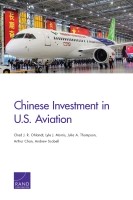| 来源类型 | Research Reports
|
| 规范类型 | 报告
|
| DOI | https://doi.org/10.7249/RR1755
|
| ISBN | 9780833097149
|
| 来源ID | RR-1755-USCC
|
| Chinese Investment in U.S. Aviation |
| Chad J. R. Ohlandt; Lyle J. Morris; Julia A. Thompson; Arthur Chan; Andrew Scobell
|
| 发表日期 | 2017
|
| 出版年 | 2017
|
| 页码 | 124
|
| 语种 | 英语
|
| 结论 |
Context- China will likely account for up to one-fifth of global demand for large commercial aircraft (LCA) and is trying to grow its currently underdeveloped domestic general aviation (GA) industry.
- China's unambiguous policy drives a whole-of-government effort to develop a globally competitive aviation industry by producing LCA and expanding China's domestic GA market.
Investments- Chinese investments in U.S. aviation have grown in scope and quantity over the past decade but are limited to smaller GA companies with technologies not particularly relevant to commercial or military aircraft, likely because of effective U.S. export and foreign investment regulations.
- Given the GA nature of most of the investments by Chinese firms to date, there are few technology-transfer concerns. The main benefits to China's industry would be on the business-process side, such as international marketing, achieving Federal Aviation Administration safety certifications, and product support.
Implications- U.S. competitiveness is unlikely to be threatened in the near term because production of China's LCA — the C919 — may be further delayed and operate less efficiently than current Western narrow-body aircraft on the international market. However, some experts remain concerned about the transfer of engine or avionics technology through COMAC C919 joint ventures with Western companies; others think technology transfers are unlikely given U.S. export controls.
- A more competitive civil aviation industry broadly supports Chinese military aviation (e.g., larger talent pool, scales of efficiency, greater supply chain options). However, direct military implications are minimal because advanced commercial aviation technology differs from military aviation technologies (e.g., stealth, radar, supersonic engines).
|
| 摘要 |
- While this study has not found any immediate concerns with Chinese investment in U.S. aviation to date, given China's aggressive aviation industrial policies, it is prudent to continue monitoring the effectiveness of U.S. export controls and foreign investment regulation.
- For additional recommendations on addressing China's industrial policies in commercial aviation such as engaging the European Union on aerospace industrial policy norms, improving transparency of Chinese aerospace actors, and monitoring the entry of the C919 into foreign markets, see "The Effectiveness of China's Industrial Policies in Commercial Aviation Manufacturing" (Crane et al., 2014 [RAND Corporation, RR-245]).
|
| 主题 | Aeronautics
; Air Transportation
; Aircraft
; China
; International Trade
; Military Aircraft
|
| URL | https://www.rand.org/pubs/research_reports/RR1755.html
|
| 来源智库 | RAND Corporation (United States)
|
| 引用统计 |
|
| 资源类型 | 智库出版物
|
| 条目标识符 | http://119.78.100.153/handle/2XGU8XDN/108492
|
推荐引用方式
GB/T 7714 |
Chad J. R. Ohlandt,Lyle J. Morris,Julia A. Thompson,et al. Chinese Investment in U.S. Aviation. 2017.
|
|
文件名:
|
x1495316273582.jpg
|
|
格式:
|
JPEG
|

|
文件名:
|
RAND_RR1755.pdf
|
|
格式:
|
Adobe PDF
|
除非特别说明,本系统中所有内容都受版权保护,并保留所有权利。